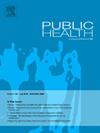Patients with non-White ethnicity and from poorer social classes are sicker at initial presentation to hospital with COVID-19 infection
IF 3.2
3区 医学
Q1 PUBLIC, ENVIRONMENTAL & OCCUPATIONAL HEALTH
引用次数: 0
Abstract
Objectives
During the COVID-19 pandemic, individuals from non-White and with poorer socio-economic status (SES) had higher rates of mortality than their counterparts. The hypothesis that these individuals had more severe respiratory failure at the time of first presentation to hospital was tested.
Study design
Observational cross-sectional study using routinely collected physiological measurements.
Methods
The study population consisted of all individuals admitted to Nottingham University Hospitals NHS Trust from 1 February 2020 and 31 December 2021. Severity of respiratory failure was measured by the oxygen saturation fraction ratio (SFR, oxygen%/inspired oxygen concentration%).
Results
Patients from the areas of highest quintiles of deprivation had an adjusted SFR of 12.6 (95 % confidence intervals [CI]: 7.4 to 17.8) units lower than patients from areas of the lowest deprivation. Patients from an Asian ethnic group has a lower SFR than those from a White ethnic group (−10.9 units; 95 % CI: −19.1 to −2.7). Sensitivity analysis adjusting for the measurement error of pulse oximetry by ethnicity increased this differential for Asian and Black ethnic groups.
Conclusions
These data suggest that individuals from both non-White ethnic groups and poorer SES are sicker at the time of presentation to hospital with COVID-19 infection. Public health strategies are required to understand these observations and counter them with appropriate interventions. These may vary from proximal factors such as enhanced access to healthcare to more distal ones including building trust in modern medical treatments. These data are from one centre and hence should be interpretated cautiously particular with generalisability to other healthcare settings.
非白人和来自较贫穷社会阶层的患者在首次就诊时病情较重
目的在2019冠状病毒病大流行期间,非白人和社会经济地位较差的个体的死亡率高于其同行。这些人在第一次到医院就诊时有更严重的呼吸衰竭的假设得到了验证。研究设计:采用常规收集的生理测量数据进行观察性横断面研究。方法研究人群包括2020年2月1日至2021年12月31日诺丁汉大学医院NHS信托收治的所有个体。用氧饱和度分数比(SFR,氧%/吸入氧浓度%)测定呼吸衰竭的严重程度。结果最贫困地区患者的调整SFR比最贫困地区患者低12.6(95%可信区间[CI]: 7.4 ~ 17.8)个单位。亚裔患者的SFR低于白人患者(- 10.9单位;95% CI:−19.1 ~−2.7)。根据种族调整脉搏血氧仪测量误差的敏感性分析增加了亚洲和黑人种族的差异。结论这些数据表明,非白人群体和较贫穷的社会经济地位的个体在COVID-19感染就诊时病情更重。需要制定公共卫生战略来了解这些观察结果,并采取适当的干预措施加以应对。这些因素可能各不相同,从近端因素,如增加获得医疗保健的机会,到远端因素,包括建立对现代医疗的信任。这些数据来自一个中心,因此应谨慎解释,特别是对其他医疗保健机构的通用性。
本文章由计算机程序翻译,如有差异,请以英文原文为准。
求助全文
约1分钟内获得全文
求助全文
来源期刊

Public Health
医学-公共卫生、环境卫生与职业卫生
CiteScore
7.60
自引率
0.00%
发文量
280
审稿时长
37 days
期刊介绍:
Public Health is an international, multidisciplinary peer-reviewed journal. It publishes original papers, reviews and short reports on all aspects of the science, philosophy, and practice of public health.
 求助内容:
求助内容: 应助结果提醒方式:
应助结果提醒方式:


